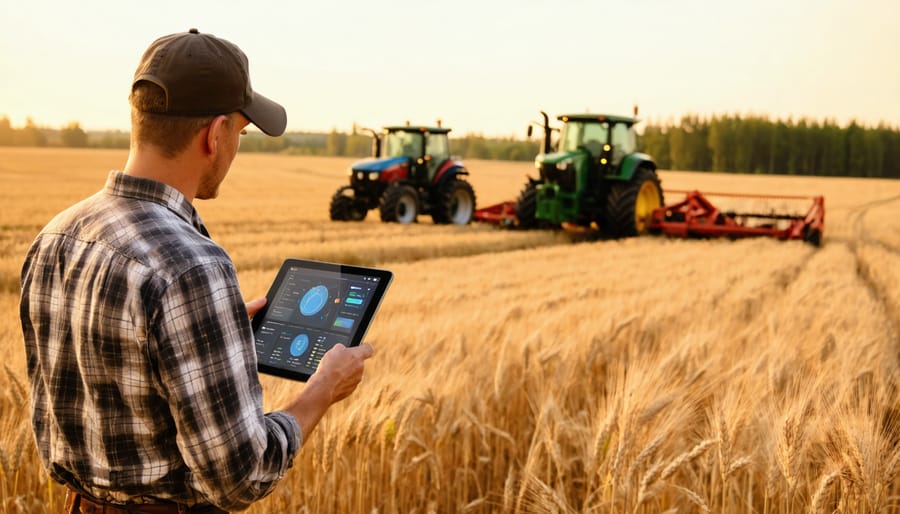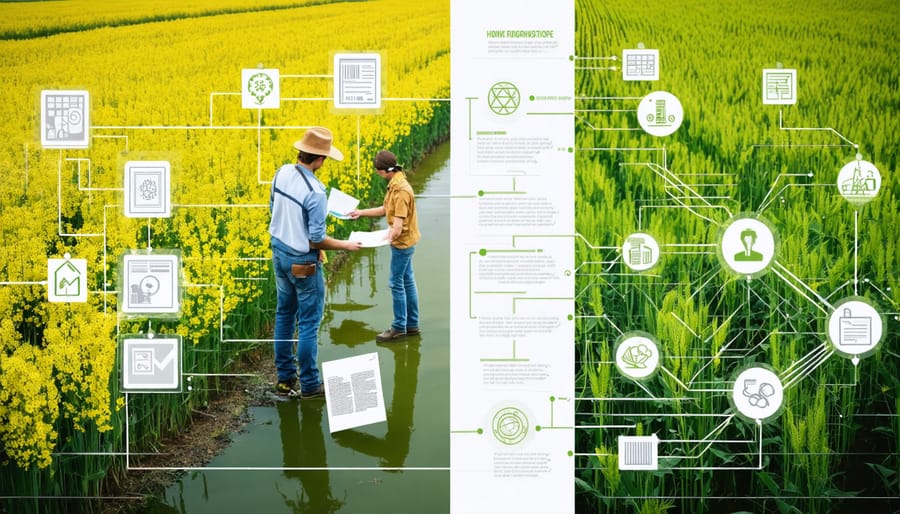Wind farms are revolutionizing Alberta’s agricultural landscape, offering farmers a powerful opportunity to diversify income while contributing to Canada’s renewable energy transformation in Alberta. Modern wind turbines can generate enough electricity to power 1,500 average homes while occupying less than one hectare of farmland, making them an ideal complement to existing agricultural operations.
For Canadian farmers, wind energy represents more than just sustainable power generation—it’s becoming a crucial component of agricultural innovation. With lease payments ranging from $8,000 to $16,000 per turbine annually, wind farms provide steady, weather-resistant income that helps stabilize farm revenues during challenging growing seasons. The minimal footprint of turbines allows for continued cultivation or grazing around their bases, maximizing land use efficiency.
As Alberta leads Canada’s wind energy expansion with over 1,800 megawatts of installed capacity, farmers are uniquely positioned to participate in this growing sector. Local success stories demonstrate how agricultural communities are strengthening their economic resilience while contributing to Canada’s clean energy goals, creating a sustainable legacy for future generations.
Why Wind Power Makes Sense for Alberta Farmers
Alberta’s Wind Energy Potential
Alberta’s wind patterns make it one of Canada’s most promising regions for wind energy development, particularly in the southern agricultural zones. The province’s average wind speeds range from 6.5 to 8.5 metres per second at typical turbine heights, with the highest potential found in areas like Pincher Creek, Crowsnest Pass, and along the eastern slopes of the Rockies.
Recent studies show that Alberta’s agricultural regions could generate up to 150 gigawatts of wind power, enough to power 15 million homes. The consistent wind patterns in these areas, especially during winter months, complement solar energy generation and provide reliable year-round power production.
Farmers in southern Alberta have reported particular success with wind installations, as the strongest winds typically occur during non-growing seasons, minimizing impact on crop production. The Medicine Hat region, for example, experiences over 300 days of wind suitable for energy generation annually.
The province’s interconnected power grid and supportive regulatory framework make it easier for agricultural operations to connect wind installations to existing infrastructure. This combination of natural resources and infrastructure positions Alberta’s farming community uniquely well for wind energy development.

Dual-Income Opportunities
Wind farms offer Alberta farmers a unique opportunity to generate two distinct revenue streams from the same land. While traditional farming activities continue below, wind turbines quietly generate sustainable income from above. Many farmers are discovering that cutting energy costs with wind power is just the beginning of their financial benefits.
Typically, farmers can expect to maintain 95-98% of their agricultural operations while hosting wind turbines. The footprint of each turbine, including access roads, usually occupies less than one hectare. Annual lease payments for hosting turbines can range from $8,000 to $16,000 per turbine, providing stable income regardless of crop yields or market fluctuations.
Local success stories, like the Henderson family farm near Pincher Creek, demonstrate how wind energy complements existing operations. Their wheat and canola production remained consistent while generating additional revenue from three turbines. This dual-income approach has helped many Alberta farmers weather agricultural market volatility while contributing to Canada’s renewable energy goals. The steady income from wind generation often helps finance farm improvements and provides financial security for future generations.
Getting Started with Farm-Based Wind Energy

Site Assessment and Planning
Before breaking ground on a wind farm project, thorough site assessment and planning are crucial steps that can make or break your investment. Here in Alberta, we’re blessed with some of the best wind resources in Canada, but finding the right spot takes more than just feeling a strong breeze.
First, you’ll want to conduct a comprehensive wind resource assessment, typically lasting 12-24 months. This involves installing meteorological towers equipped with anemometers to measure wind speed, direction, and consistency at different heights. Most successful wind farm sites in Alberta show average wind speeds of at least 6.5 metres per second at hub height.
Your land’s topography plays a vital role too. Ideal sites have minimal obstacles like trees or buildings that could create turbulence. Consider factors like soil composition for turbine foundations and proximity to existing power lines – connecting to the grid from remote locations can significantly impact your project’s budget.
Environmental impact studies are essential. Work with local wildlife experts to assess bird migration patterns and habitat considerations. Many Alberta farmers have found that wind farms can coexist harmoniously with both crops and livestock, often using less than 2% of the total land area.
Access is another key consideration. Your site needs good road infrastructure for construction vehicles and ongoing maintenance. Local municipalities can provide guidance on required setbacks from roads and property lines, which typically range from 40 to 50 metres in Alberta.
Navigating Permits and Regulations
Setting up a wind farm in Alberta requires careful navigation through several regulatory channels. The Alberta Utilities Commission (AUC) serves as your primary point of contact, overseeing the approval process for wind energy projects larger than 1 megawatt. Farmers typically need to secure three main permits: the AUC approval, environmental assessments from Alberta Environment and Parks, and municipal development permits.
The process begins with a detailed project proposal submission to the AUC, including environmental impact assessments, noise studies, and wildlife surveys. These studies typically take 6-12 months to complete. Local municipalities require separate development permits, focusing on land use compatibility and community impact.
For projects near airports or above 20 metres in height, Transport Canada approval is mandatory. Alberta’s agricultural zones often have specific setback requirements, typically 400 metres from residences, though this varies by municipality.
One helpful resource is the AUC’s participant involvement program, which guides farmers through community consultation requirements. Local residents within 2 kilometres of proposed turbines must be notified and given opportunities to provide feedback.
Time frames for complete approval typically range from 18-24 months. Working with an experienced renewable energy consultant can help streamline the process. Many successful Alberta wind farms started with farmers forming cooperatives to share costs and expertise through the permitting phase.
Remember to engage early with utility companies regarding grid connection requirements and capacity assessments.
Connecting with Energy Partners
Building successful wind energy partnerships starts with connecting to established developers in Alberta. The Canadian Renewable Energy Association (CanREA) maintains a comprehensive directory of wind energy companies actively seeking agricultural partnerships across the province. These developers bring both the expertise and capital needed to transform your agricultural land into a renewable energy asset.
To begin exploring opportunities, reach out to your local municipality’s economic development office, as they often maintain relationships with renewable energy companies operating in the region. The Alberta Utilities Commission website also provides valuable resources and lists of approved wind energy developers.
Many successful Alberta farmers recommend starting with informal conversations at agricultural trade shows and renewable energy conferences, where developers frequently seek potential partners. The annual CanWEA Operations Summit, typically held in Calgary, offers excellent networking opportunities with industry leaders.
When evaluating potential partners, look for developers with:
– A proven track record in Alberta agricultural communities
– Clear communication practices and transparent business terms
– Strong financial backing and project completion history
– Experience working with local permit requirements
– Commitment to agricultural land preservation
Consider joining local renewable energy cooperatives or farmers’ associations that focus on wind energy development. These groups often provide valuable introductions and share experiences about working with different developers. Remember to consult with legal professionals who specialize in renewable energy contracts before finalizing any partnerships.
Real Success Stories from Alberta Farms

The Johnson Family Farm Transformation
The Johnson family farm, located just outside of Pincher Creek, Alberta, has become a shining example of successful wind energy integration in agricultural operations. In 2018, Tom and Sarah Johnson made the bold decision to lease 40 hectares of their 400-hectare cattle ranch for wind turbine installation.
Working with a local renewable energy developer, the Johnsons installed three 2.5-megawatt turbines, carefully positioned to minimize impact on their grazing operations. The project required an initial adjustment period, but their cattle quickly adapted to the presence of the turbines, continuing to graze contentedly beneath the rotating blades.
“The steady income from the wind farm has helped us weather the ups and downs of farming,” explains Sarah Johnson. “We’re now earning approximately $25,000 annually per turbine, which provides crucial stability for our operation.” The family continues to run their cattle operation at nearly full capacity, with only 3% of their grazing land affected by the turbine footprint and access roads.
The project has also brought unexpected benefits to their farm. The improved access roads have made it easier to move equipment during harvest season, and the additional income has allowed them to invest in more efficient irrigation systems. The Johnsons now host regular farm tours for neighboring farmers interested in wind energy, sharing their experiences and helping build a stronger, more sustainable farming community in southern Alberta.
Pincher Creek Wind Coalition
The Pincher Creek Wind Coalition stands as a shining example of how rural communities can successfully embrace wind energy development while maintaining their agricultural heritage. Established in 2018 by a group of forward-thinking farmers in southern Alberta, this initiative has grown to include over 40 local landowners who collectively manage 3,000 hectares of wind-integrated farmland.
The coalition demonstrates the power of community-led climate initiatives, generating enough clean energy to power 25,000 homes while allowing continued farming operations. Participating farmers report annual returns of $15,000 to $25,000 per turbine, significantly supplementing their agricultural income.
What makes the Pincher Creek model unique is its collaborative approach to negotiations with energy companies. By working together, farmers secured better lease terms and established standardized environmental protection protocols that preserve local wildlife corridors and protect valuable topsoil during construction.
The coalition also pioneered a profit-sharing structure that ensures benefits are distributed equitably among participating landowners, regardless of turbine placement. This approach has helped maintain community harmony and created a template for other farming regions looking to develop wind resources. Their success has inspired similar initiatives across Alberta, with three new farmer-led wind coalitions launching in 2023.
Environmental Impact and Sustainable Practices
Soil and Crop Impact Studies
Recent studies conducted across Alberta’s farming regions have shown that wind turbines have minimal impact on crop yields and soil health management practices. Research from the University of Alberta indicates that the shadow flicker and temperature variations caused by turbines affect less than 1% of the total farmland area, primarily in the immediate vicinity of the tower base.
Farmers report successfully cultivating various crops, including wheat, canola, and pulses, right up to the turbine access roads. The compact footprint of modern wind turbines typically occupies only 0.3 to 0.5 hectares per turbine, allowing for continued agricultural activities on more than 98% of the land.
Environmental monitoring has demonstrated that soil composition and moisture levels remain largely unchanged in fields with wind turbines. Some farmers have even noticed benefits, such as snow retention during winter months, which can increase soil moisture content for spring planting. Additionally, the access roads required for turbine maintenance can improve field accessibility during wet conditions, enabling more efficient farming operations.
Studies from Southern Alberta farming communities show that implementing proper setbacks and thoughtful turbine placement can create a harmonious relationship between wind energy generation and agricultural production.
Wildlife Considerations
Protecting local wildlife is a crucial responsibility for wind farm operators in Alberta. Regular monitoring of bird and bat populations helps minimize impact on these species. Best practices include installing radar systems to detect approaching flocks and automatically adjusting turbine operation during peak migration periods.
Farmers can work with wildlife experts to establish buffer zones around known nesting areas and important habitats. Painting one turbine blade black has shown promising results in reducing bird collisions by up to 70%. Installing ultrasonic acoustic deterrents helps protect bat populations by creating an uncomfortable environment that encourages them to avoid turbine areas.
Regular maintenance schedules should account for breeding seasons, with major work planned outside these sensitive periods. Many Alberta farmers have successfully integrated wildlife protection measures by creating wildlife corridors between turbines and maintaining native vegetation around turbine bases.
Working with local conservation groups helps develop site-specific strategies that balance energy production with wildlife protection. Remember, healthy ecosystems contribute to successful farming operations, making wildlife protection an investment in your land’s long-term sustainability.
Wind farming represents a significant opportunity for Alberta’s agricultural community to diversify income while contributing to Canada’s renewable energy future. Throughout this guide, we’ve explored how wind energy can complement existing farming operations, from initial assessment and planning to implementation and ongoing management.
The benefits are clear: steady additional income through land lease agreements, continued agricultural use of most farmland, and reduced carbon footprint. Success stories from fellow Alberta farmers demonstrate that wind energy projects can thrive alongside traditional farming practices, creating sustainable, long-term revenue streams for farming families.
To get started with your wind farm project, begin by conducting a wind resource assessment of your property and consulting with local renewable energy experts. Connect with your municipal authorities to understand zoning requirements and reach out to the Alberta Utilities Commission for guidance on regulatory compliance. The Canadian Renewable Energy Association offers valuable resources and can connect you with experienced developers in your area.
Remember that community engagement is crucial. Share your plans with neighbours early in the process and consider forming or joining local renewable energy cooperatives. Support is available through various provincial and federal programs designed to help farmers transition to renewable energy projects.
By embracing wind energy, you’re not just investing in your farm’s future – you’re helping build a more sustainable agricultural sector for generations to come. Take that first step today by reaching out to local wind energy developers or your municipal planning office.











